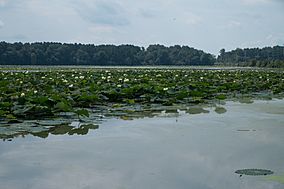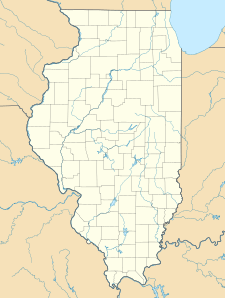Crab Orchard National Wildlife Refuge facts for kids
Quick facts for kids Crab Orchard National Wildlife Refuge |
|
|---|---|
|
IUCN Category IV (Habitat/Species Management Area)
|
|

Crab Orchard Lake, Crab Orchard National Wildlife Refuge, September 2019
|
|
| Location | Williamson, Jackson, and Union counties, Illinois, USA |
| Nearest city | Marion, Illinois |
| Area | 43,890 acres (177.62 km2) |
| Established | 1947 |
| Governing body | U.S. Fish and Wildlife Service |
| Website | Crab Orchard National Wildlife Refuge |
The Crab Orchard National Wildlife Refuge is a huge natural area in southern Illinois, United States. It covers about 43,890 acres (180 km²). Most of it is in Williamson County, but parts extend into Jackson and Union counties.
This refuge is home to many different plants and animals. It's built around Crab Orchard Lake, which is a big part of its natural beauty. Other important lakes here are Devil's Kitchen Lake and Little Grassy Lake. The refuge has many types of habitats, like forests, farms, grasslands, wet areas, and lakes.
Contents
What is Crab Orchard National Wildlife Refuge?
This special place helps protect wildlife. It's a key resting spot for birds that fly along the Mississippi Flyway. This is a major path birds use when they migrate. In winter, you can see as many as 200,000 Canada geese here!
The refuge is full of life. Scientists have found almost 1000 different types of plants. There are also 245 kinds of birds, 33 types of mammals, 63 kinds of fish, and 44 types of reptiles and amphibians. It's like a giant outdoor classroom for nature lovers!
Exploring the Refuge
The western part of the refuge, about 24,000 acres (97 km²), is open for fun activities. This area also includes a 4,050-acre (16 km²) wilderness area. A wilderness area is a wild place where nature is protected and human activity is limited.
The eastern part, about 20,000 acres (81 km²), is a wildlife sanctuary. This means public access is limited to keep the animals safe and undisturbed.
About 1,000,000 people visit the refuge each year. Some parts of the refuge are also used for industrial activities. Many buildings here were used for manufacturing during World War II. Today, these buildings are rented out to private companies for storage.
The Crab Orchard National Wildlife Refuge has four main goals:
- Wildlife Management: Making sure there's enough food and resting places for migrating birds and other animals.
- Agriculture: Working with farmers to grow crops that also help feed the wildlife.
- Recreation: Providing fun outdoor activities for visitors.
- Industry: Allowing some industrial activities that support the local economy.
Crab Orchard Wilderness Area
Inside the refuge, there's a special place called the Crab Orchard Wilderness. This is a federally protected wilderness area that covers 4,050 acres (16 km²). It's located at the very southern end of the refuge. Wilderness areas are kept as wild as possible, with very few changes from humans. This helps protect the natural environment and its animals.
Plants of the Refuge
The refuge is home to a wide variety of plants. Here's a quick look at the different plant groups found there:
| Flora of Crab Orchard National Wildlife Refuge | ||||
|---|---|---|---|---|
| Plant Group | Families | Genera | Species | |
| Pteridophytes (Ferns & Allies) | 15 | 20 | 27 | |
| Gymnosperms | 3 | 4 | 9 | |
| Monocots | 26 | 111 | 300 | |
| Dicots | 96 | 353 | 645 | |
| Totals | 140 | 488 | 981 | |


